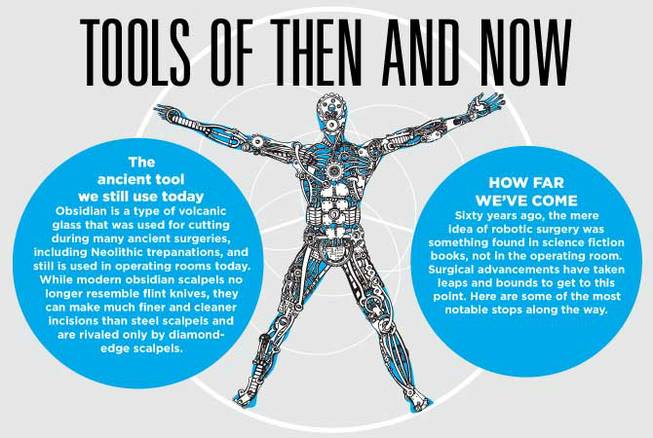
Sunday, July 5, 2015 | 2 a.m.
Robotic surgery is one of the most exciting innovations in medical technology for doctors and patients.
Building on the minimally invasive laparoscopic method, the da Vinci robot surgical machine allows surgeons to operate within the body without having to cut large incisions. “The robotic method lets us complete complex surgeries on the inside of the body, but from the outside, it’s just a series of small incisions,” said Dr. Allison Davis, MD, a general surgeon with the Las Vegas Institute for Robotic Surgery at MountainView Hospital.
While the idea of using a robotic machine during surgery might sound intimidating, it makes many formerly complicated procedures much simpler.
How does robotic surgery work?
Robotic surgery, or robot assisted laparoscopic surgery, has revolutionized the minimally invasive laparoscopic technique.
During laparoscopic surgery, a surgeon makes a series of small incisions into which she inserts instruments mounted on thin sticks, including a device with a small camera lens.
“Laparoscopic is a great technique, but it can be limiting,” Davis said. “The two main problems is that the image during surgery is only 2-D, so depth perception is an issue, and the instruments aren’t as mobile. They can only move side to side, and up and down.”
Robotic surgery improves both of those concerns. The camera lens used by the da Vinci robot machine produces a clear, 3-D image for the surgeon, granting the same quality, real-time image the surgeon would have during open surgery. The da Vinci robot also is equipped with wristed instrumentation, meaning the robot has a full 360-degree range of motion and mimics the surgeon’s movements one to one.
To further ensure top-quality results, lab technicians carefully review and analyze statistics from the machine after each procedure. This guarantees the robot is functioning optimally and indicates whether any maintenance or troubleshooting is necessary.
“Robotic surgery gives surgeons all the benefits of open surgery, such as fluid motion and a complete visual range, without actually having to open the patient up,” Davis said.
What that means for patients is a far less traumatic procedure and a quicker healing process. The incisions made during robotic surgery usually are 5 millimeters or smaller, which cuts down on pain, healing time and scarring.
“Open abdominal surgeries can leave patients with a four-to-six week healing time, but with robotic surgery, many patients are able to walk out of the hospital that day,” Davis said.
How far we’ve come
Sixty years ago, the mere idea of robotic surgery was something found in science fiction books, not in the operating room. Surgical advancements have taken leaps and bounds to get to this point. Here are some of the most notable stops along the way.
6500 B.C.: Evidence of trepanation, the first surgical procedure, dates to 6500 B.C. Trepanation was the practice of drilling or cutting a hole through the skull to expose the brain. This was thought to cure mental illness, migraines, epileptic seizures and was used as emergency surgery after a head wound.
1540: Once rivals, the Barbers Company and the Guild of Surgeons combined their expertise to create the United Barber-Surgeons Company in England. The group performed tooth extractions and blood-letting, in addition to the occasional haircut.
1843: The first hysterectomy was performed in England.
1846: Surgical anesthesia was demonstrated for the first time by American dentist William T. G. Morton using the inhalation of ether. Prior to this discovery, all patients had to undergo operations, including amputations, while awake.
The ancient tool we still use today
Obsidian is a type of volcanic glass that was used for cutting during many ancient surgeries, including Neolithic trepanations, and still is used in operating rooms today. While modern obsidian scalpels no longer resemble flint knives, they can make much finer and cleaner incisions than steel scalpels and are rivaled only by diamond-edge scalpels.
1867: British surgeon Joseph Lister created antiseptic using carbon acid, and he published a study citing the importance of cleanliness and sterility during surgery. In the following years, the mortality rate for surgical patients fell dramatically.
1895: The first X-ray was performed in Germany.
1896: The first successful heart surgery was performed.
1917: The first documented plastic surgery was performed on a burn victim.
1928: Antibiotics were discovered.
1950: The first successful organ transplant occurred.
1954: The first successful living donor kidney transplant occurred between identical twin brothers.
1967: The first successful liver transplant occurred.
1975: Laparoscopic surgery was performed.
1985: The first documented robotic surgery was performed.
2000: The da Vinci robot was granted FDA approval for laparoscopic surgery.

Join the Discussion:
Check this out for a full explanation of our conversion to the LiveFyre commenting system and instructions on how to sign up for an account.
Full comments policy